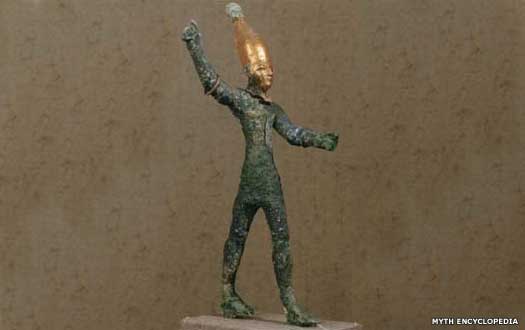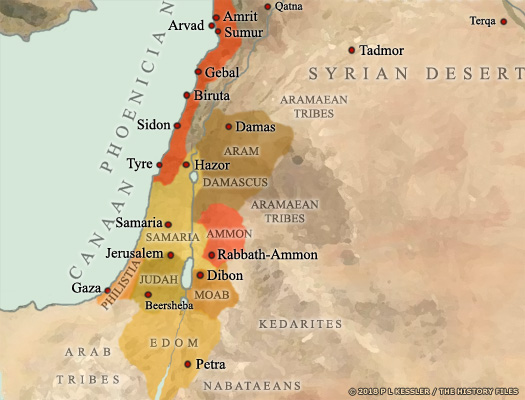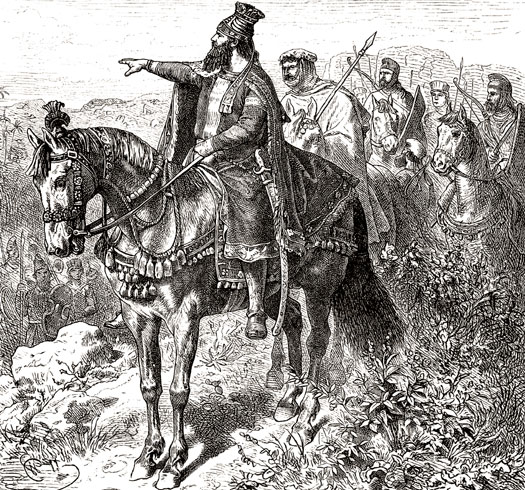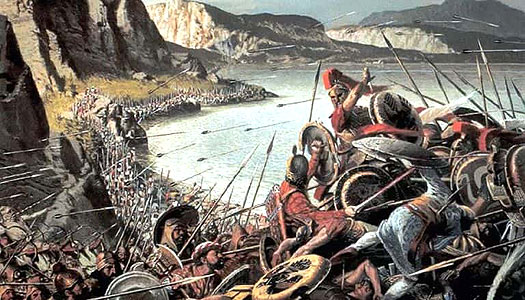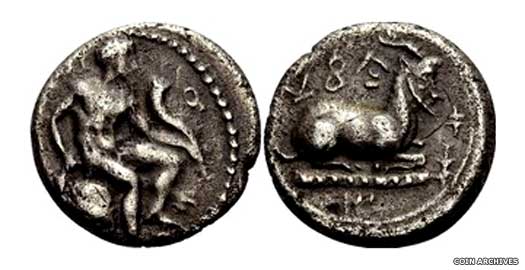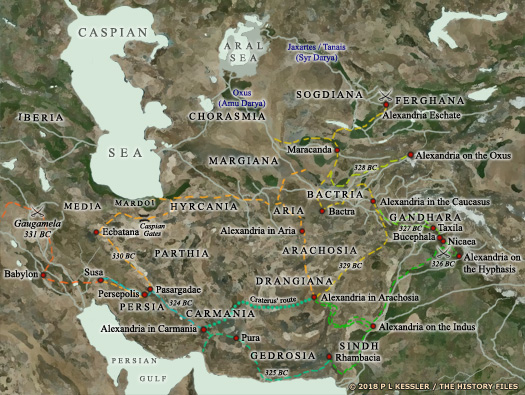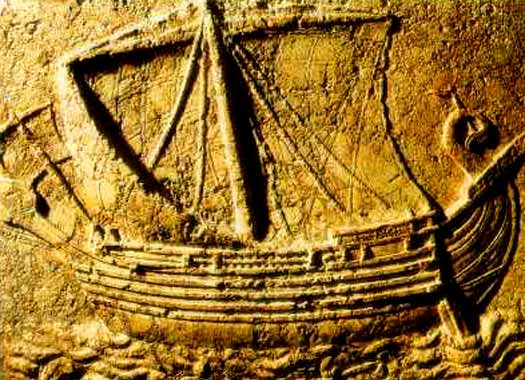
| TYRE Founded by Sidon around 2750 BC, according to Herodotus, or perhaps by 2250 BC according to archaeological evidence, Tyre began life as a settlement which was smaller and less influential than its mother city. However, it eventually surpassed all other Phoenician cities in terms of its wealth and influence. Tyre was originally located on a coastal island some 80km (50 miles) south of Biruta, with another settlement area on the mainland itself. Although the two settlements may have fought each other on more than one occassion, normally they were united in the defence of the city. The Greek king, Alexander the Great, had to build a vast rampart to bridge the gap between Tyre and the mainland in 332 BC to force the city to open its doors, and this causeway served as the foundation for a permanent corridor which still connects the island, now a peninsula, today.
Modern Tyre lies in Lebanon, near its southern border, and forms the country's fourth-largest city. The details surrounding pre-Phoenician Canaanite kings were passed down only in Hellenic mythology.
(Additional information from Jewish Antiquities, Flavius Josephus.)
c.2000 - 1800 BC :
Egypt maintains a trading presence in the region.
fl c.1500 BC :
Agenor : A king of Tyre according to Herodotus.
c.1500 BC :
According to Greek legend, Agenor is the father of five sons, Cadmus, Cilix, Phineas, Phoenix, and Thasus. All depart their Phoenician home in search of their sister, Europa, who had been abducted by Zeus (and who may instead be the daughter of Phoenix rather than his sister).
Cadmus travels to Greece where he founds and rules over Thebes before moving to rule over the Enchelei tribe of Illyrians. Phineas gives up his search in eastern Thrace, where he settles on the western shores of the Black Sea and rules a city state of his own. Phoenix inherits the throne of Tyre and becomes the eponymous founder of the Phoenicians.
fl c.1490 BC :
Phoenix : Son (or brother in some sources). Inherited throne.
1453 BC :
The Egyptians conquer the Levant and Syria and establish three provinces in their conquered territories which are named Amurru (in southern Syria), Upe (in the northern Levant), and Canaan (in the southern Levant). Each one is governed by an Egyptian official. Native dynasts are allowed to continue their rule over the small states, but have to provide annual tribute.
fl c.1400 BC :
Eri-Aku : A semi-legendary model for the later Herakles.
fl c.1370s BC :
? : Prince of Tyre. Vassal of Egypt.
c.1360s - 1310s BC :
Abi-Milki / Abimilku : Son. Prince of Tyre. Vassal of Egypt.
c.1371 - 1358 BC :
The Amarna letters between Egypt and the city states of Syria and Canaan describe the disruptive activities of the habiru, and of Hazor, which is accused of siding with them to capture several cities belonging to Tyre and Ashtaroth. Abi-Milki is often the subject of speculation by scholars who wonder if he is linked to the frequent mentions of various pre-Philistine rulers named Abimelech (Gerar has two in succession). The speculation is not without some basis, as a coincidentally similar Milkilu is king of the Palestinian city of Gezer at the same time.
c.1320 BC :
The king of Gebal, Rib-Adda, reports to his Egyptian overlords that his kinsman, the king of Tyre, and his family have been murdered in a coup d'etat.
This photo shows a bronze figure from Tyre, created between 1400-1200 BC and probably representing the Canaanite god Baal in the role of a warrior fl c.1230 BC :
Aribas
fl c.1220 BC :
Baal-Termeg
c.1200 BC :
There is general collapse in the region as instability grips the Mediterranean coast and the Hittite empire is destroyed by the Sea Peoples and various other groups. Arvad, Gebal, Sidon, and Tyre, all with prominent harbours, manage to survive unscathed, although the wealthy customers disappear for a time. It is possible that there is an influx of elements of the Sea Peoples into southern Canaan, where they contribute towards creating later Phoenicia's great maritime society.
fl c.1193 BC :
Baal
c.1163 - 1125 BC :
Pummay
Phoenician Tyre :
Descended from the Canaanites who formerly inhabited the entire Levant region, these later Canaanites occupied the long coastal strip that forms modern Lebanon. The great Phoenician island city of Tyre was founded by settlers from Sidon, and it quickly grew to rival its neighbour, with each of them claiming to be the mother city of Phoenicia. Like the other Phoenician cities, Tyre founded colonies along the western Mediterranean coastline, and was principally responsible for the creation of Carthage. It also formed the heart of a very large region, as can be inferred by various finds that place the northern limits of the territory at Kherayeb, some ten kilometres to the north of the city, while its southern frontier can be placed at Umm el-Ahmed, twenty kilometres away.
Phoenicians still thought of themselves as Canaanites; it was the Greeks who coined the name Phoenicia. The Phoenician language was very closely related to ancient Hebrew. Unfortunately, one technological advance of the time was the use of parchment and papyrus for record-keeping instead of clay tablets. These are highly perishable, and few have survived.
As for Tyrian chronology, the city's own dates are approximate, contained in a king-list from Josephus Against Apion I.117–26, plus Hebrew and Assyrian synchronisms and other evidence. Usefully, Cross covers the kings from Hiram I to Pummayyonx (Pygmalion).
(Additional information from Jewish Antiquities, Flavius Josephus, from An Interpretation of the Nora Stone, F M Cross (Bulletin of the American Schools of Oriental Research, CCVIII (1972)), from History of Tyre, H J Katzenstein (Jerusalem, 1973), and from External Links: An Updated Chronology of the Reigns of Phoenician Kings during the Persian Period (539-333 BC), Josette Elayi (Trans 32, 2007, available in English at DigitOrient), and Kingdom of Tyre (Oxford Reference).)
1104 - 1101 BC :
The traditional date of founding for Gadir is 1104 BC, while Utica is founded in 1101 BC. This puts them both at the very beginning of the appearance of Phoenician culture in the Near East. No archaeological evidence for occupation at this date can be found for either settlement, but, this is probably because these posts are temporary at first, and are not permanently occupied until the ninth century.
c.1050 BC :
A weakened Egypt loses its remaining imperial possessions in Canaan. Tyre begins founding trading colonies or making permanent its existing outposts along the western Mediterranean coast, including that of Utica in North Africa.
10th cent - 701 BC :
Tyre gains pre-eminence over much of Phoenicia, including being able to control Byblos and Sidon. The chronology for the first dynasty of kings, between Abi-Baal and Pummayyonx, is somewhat uncertain. Various alternative dates have been given, although generally they range about by no more than about a decade on either side of the dates given here. An example of one of the most dramatic differences is Hiram I, who could be assigned dates of circa 962-929 BC instead. Even the list provided by Josephus is controversial.
c.1000 - 980 BC :
Abi-Baal / Abibaal : Dynasty founder.
c.980 - 946 BC :
Hiram I : Son. It is during Hiram's reign that Tyre grows, surpassing its mother city, Sidon, to become the most important Phoenician city. Hiram also puts down a rebellion in Utica.
c.955 BC :
The Israelite First Temple of Jerusalem is completed, apparently by craftsmen from Sidon under Hiram's authority.
946 - 929 BC :
Baal-Eser / Ethbaal / Etzel-Baal I : Son. His daughter, Jezebel, married Ahab of Samaria.
929 - 920 BC :
Abd-Ashtart / Abdastratus / Astartus : Brother.
920 - 900 BC :
Ashtart / Methusastartus
900 - 888 BC :
Dalay-Ashtart : Brother of Abd-Ashtart.
888 - 879 BC :
Ashtar-rom / Astarymus / Asermymus : Brother. Murdered by Phelles.
c.880s BC :
Omri is one of the most powerful kings of the small state of Samaria. He establishes closer ties with Tyre in an attempt to draw away some of the wealth and prosperity of his rival, Damas. Tyre itself undergoes a renaissance, principally under Eshbaal from 878 BC, increasing its international power and trade. However, records concerning subsequent kings are uncertain about the order of succession.
When the Neo-Assyrian empire threatened the various city states of southern Syria and Canaan around 853 BC, they united to protect their joint territory - successfully it seems, at least for a time 879 - 878 BC :
Phelles / Pheles : Brother. Reigned for eight months.
878 - 847 BC :
Itto-Baal / Eshbaal I : Priest of Astarte. Dates sometimes given as 887-856 BC.
847 - 841 BC :
Baal-Eser II / Balbazer : Son. Also shown as Baalmazzar (849-830 BC).
841 - 832 BC :
Mattan I : Son.
833 BC :
This is the date given for the founding of Carthage by Menander the Ephesian, although a more widely accepted date is 814 BC, below.
832 - 785 BC :
Pummayyonx / Pumayyaton : Son. 'Pygmalion'. Ascended aged eleven.
814 BC :
Pumayyaton is more readily remembered as Pygmalion. In the seventh year of his reign his sister, Elissa, flees Tyre and founds a colony on the north African coast by the name of Carthage. Although the story itself may be apocryphal, the founding point for Carthage falls between about 843-813 BC, showing that there is a historical truth behind the tale.
Also during Pumayyaton's reign, the heart of Tyre's trading empire appears to shift away from the Near East and towards the Mediterranean, concentrating more on building up new colonies such as Carthage, and Kition on Cyprus. The main reason is almost certainly the rise of Assyria to the east. In this century it has already completed its conquest of much of Syria, and areas of Philistia and Urartu, with Carchemish paying tribute in 882 BC and apparently becoming a vassal in 870 BC.
785 - 750 BC :
There is an unexplained gap in the succession following the rule of Pumayyaton. This seems to be due to the name of the ruling king having been lost from the inscription that carries the king list.
c.750 - 740 BC :
Itto-Baal II / Eshbaal II
c.740 BC :
Tubaal
c.740 - 730 BC :
Hiram II
(Or c.736-729 BC.) :
738 BC :
All of the Phoenician states become vassals of Assyria, but local arrangements for governance are left in place. This is the century for which the first archaeological evidence for Utica's existence can be dated, showing that the colony becomes a permanent settlement by a date of 700 BC at the very latest.
730 - 729 BC :
Mattan II
729 - 701 BC :
Eluli / Elulaios / Luli
709 BC :
Elulaios petitions Sargon the Great, claiming that the kings of Cyprus are not paying the tribute that he feels he is owed. As a result, it seems that the Assyrian empire conquers the island for this reason alone, albeit with his fleet being provided by Tyre.
704 - 701 BC :
With the death of Sargon II of Assyria, many of the former subject states rebel. It takes the Assyrians until 701 BC to get around to quelling the Phoenician states. Tyre and Sidon fall without a fight, and the cities in their orbit surrender.
701 - 660 BC :
Baal I
694? - 680 BC :
Abd Melqart / Abd Melkarth : Vassal to Assyria.
663 BC :
Tyre surrenders to Ashurbanipal of Assyria as the empire conquers all of Phoenicia, drawing it directly into the empire.
fl 660s BC :
Abdimilkutte : May be the same as Abd Melkarth (694-680 BC).
c.612 BC :
Tyre restores its control of Byblos, but apparently loses control of Sidon.
591 - 573 BC :
Itto-Baal / Eshbaal / Ethbaal III
c.587 - 574 BC :
Nebuchadnezzar II of Babylonia annexes many previously independent states in the west in his quest for complete dominance of Syria-Palestine. The siege of Tyre lasts for thirteen years, and with its conclusion the colony of Carthage declares its independence from its subjugated mother city.
573 - 564 BC :
Baal II : Vassal of Babylonia.
564 BC :
Yakinbaal : Vassal of Babylonia.
564 BC :
Still under Babylonian domination, the monarchy of Tyre is overthrown. The city is governed by an oligarchy which is headed by judges ('shoftim').
Shoftim of Tyre :
When the monarchy of Tyre was overthrown in the 560s BC, an oligarchy formed a new governmental body which was headed by judges, or shoftim (the singular term is 'shofet'). The shoftim were both executive power and judicial leaders, but they usually held no military power. In Carthage, which operated a similar system, it appears that each shofet was elected by the citizens, and held office for a one year term. Quite possibly there were two of them at a time, mirroring the system of consulship later used by Rome, but the exact details of Tyre's short-lived system are less clear.
(Additional information from Jewish Antiquities, Flavius Josephus.)
564 - 563 BC :
Chelbes : The first shoftim of Tyre to govern.
563 - 562 BC :
Abbar
562 - 556 BC :
Mattan III : Shoftim, but the same name applied to a later king.
562 BC :
Mattan III is (apparently) restored in the 490s BC, but as a king rather than a shoftim (judge). It is highly unlikely that he is the same Mattan III though, as this would make him at least ninety years of age. Some modern records show the latter Mattan as Mattan IV instead.
562 - 556 BC :
Ger Ashthari : Co-ruler of Tyre.
556 - 555 BC :
Baal-Eser III : The last shoftim ruler. Removed by Hiram III?
555 - 551 BC :
Mahar-Baal / Merbalos : King? Brother of Hiram III of the Restored Kings.
555 - 551 BC :
Babylonian Tyre restores its kingship between 555-551 BC, although the details of the regime change are extremely sketchy due to the lack of surviving records. In 551 BC Hiram III is noted as king, but whether he governs from 555 BC is unknown. There could instead be a somewhat messy period of conflict here? The king list inscription contains Bal-Eser III, seemingly confirming him as a king rather than a shoftim, while Mahar-Bal (Merbalos in Greek) is another king, and brother to Hiram III no less, who certainly does claim the title of king.
Kings of Tyre Restored & Dominated (Babylonia, Persia, & Greeks) :
The city of Tyre had been started off as a colony of Sidon, one that was smaller and less influential than its mother city but which eventually surpassed it and all other Phoenician cities in terms of its wealth and influence. Descended from the Canaanites who formerly inhabited the entire Levant region, Phoenicians still thought of themselves as Canaanites even after their greatest days were behind them, and their language was very closely related to ancient Hebrew. It was the Greeks who coined the name Phoenicia ('phoinikes', meaning 'purple people', from the famed purple dye they produced from the shells of the Murex shellfish). Unfortunately, one technological advance during the city's greatest independent period was the use of parchment and papyrus instead of clay tablets for record-keeping. These are highly perishable, and few have survived.
Like the other Phoenician cities, at its height Tyre had founded colonies along the western Mediterranean coastline, and was principally responsible for the creation of Carthage. It also formed the heart of a very large region, as can be inferred by various finds that place the northern limits of the territory at Kherayeb, some ten kilometres to the north of the city, while its southern frontier can be placed at Umm el-Ahmed, twenty kilometres away. Independence ended in 738 BC when Assyria invaded and conquered the Levant.
Local arrangements for governance were allowed to continue, however, setting a pattern for subsequent domination by Babylonia, Persia, and the Greek empire of Alexander the Great. One of the main reasons for this, especially under the Persians, was that it was the Phoenicians who made up much of the empire's naval forces, both building and manning the ships. Babylonian Tyre restored its kingship between 555-551 BC, replacing the Shoftim (judges), although the details of the regime change are extremely sketchy due to the lack of surviving records. Unfortunately for Tyre, the restoration of the monarchy came shortly before the Persian empire took ownership of the region in 539 BC. Achaemenid-era Phoenicia formed part of a large satrapy which was commanded from Babirush (Babylon) and which included Ebir-nāri (Syria). Later Achaemenid Syria and Phoenicia seem to have been established as a single satrapy in their own right, away from oversight by Babylon. Ebir-nāri dominated this arrangement, with a capital that was probably at Damascus or Achaemenid-era Sidon.
Tyre was originally located on a coastal island some eighty kilometres south of Biruta (and was known as the 'New City'), with another settlement area on the mainland itself (the 'Old City'). During the Persian period it also dominated the smaller city of Ashqelon (Ashkelon, previously part of Philistia). When Greek domination of the region arrived in 332 BC in the form of Alexander the Great, his forces had to build a vast rampart to bridge the gap between Tyre on its coastal island and the mainland. This causeway served as the foundation for a permanent corridor which still connects the island today, now a peninsula. Today's Tyre lies in Lebanon, near its southern border, and forms the country's fourth-largest city.
(Information by Peter Kessler, with additional information from The Persian Empire, J M Cook (1983), from The Histories, Herodotus (Penguin, 1996), from The Cambridge Ancient History, John Boardman, N G L Hammond, D M Lewis, & M Ostwald (Eds), from Alexander the Great, Krzysztof Nawotka (Cambridge Scholars Publishing, 2009), from Jewish Antiquities, Flavius Josephus, and from External Links: Encyclopædia Britannica, and the Nabonidus Chronicle, contained within Assyrian and Babylonian Chronicles, A K Grayson (Translation, 1975 & 2000, and now available via Livius in an improved version), and Encyclopaedia Iranica, and Ancient History Encyclopaedia, and The Role of the Phoenician Kings at the Battle of Salamis (480 BC), Josette Elayi (Journal of the American Oriental Society Vol 126, No 3 (Jul-Sep 2006), pp 411-418, available via JSTOR), and An Updated Chronology of the Reigns of Phoenician Kings during the Persian Period (539-333 BC), Josette Elayi (Trans 32, 2007, available in English at DigitOrient).)
551 - 532 BC :
Hiram / Eiromos III : Headed a restored kingship, replacing the Shoftim.
539 BC :
Tyre and all of Phoenicia is submerged within the Persian empire. Tyre is one of four 'kingdoms' created by the Persians in Phoenicia, and is ruled by governors (in the form of a retained native monarchy that is lead by Hiram III - Eiromos in Greek) in the name of the Persian king. Despite Tyrian rule being maintained within the city state's territories, many Phoenicians emigrate to the colonies, especially Carthage, which quickly rises to become a major power.
Cyrus the Great freed the Indo-Iranian Parsua people from Median domination to establish a nation that is recognisable to this day, and an empire that provided the basis for the vast territories that were later ruled by Alexander the Great 532 - c.490s BC :
Given the rough dates assigned to Mattan III and the date for the end of the reign of Hiram III, there is a noticeable gap - of at least thirty years. No records appear to be available to shed light on this gap (in fact this entire period is very poorly recorded), so perhaps it could be assumed that Persian governors are placed in charge until Mattan III is (apparently) restored.
There is the possibility that one Ithobaal, mentioned in an inscription that only surfaces through archaeology in the early twenty-first century, could be the father of Mattan, and therefore - probably - the son of Hiram. In fact the inscription seems to confirm the latter theory, although more study is needed to confirm this.
532 - ? BC :
Ithobaal / Eshbaal / Ethbaal IV : Son. Possible father of Mattan IV.
c.490s BC :
According to some king lists, Mattan III is (apparently) restored to the throne. It is highly unlikely that he is the same Mattan III as the former Shoftim of Tyre of 562-556 BC as this would make him at least ninety years of age. Some modern records show the latter Mattan as Mattan IV instead. It is likely that he is the son of Ithobaal IV, although Herodotus names him as the son of Eiromos (the Greek version of Hiram). It seems unlikely that this could be Hiram III, dead since about 532 BC.Any son of his would have to be at least fifty by the time of the Battle of Salamis in 480 BC, so a Hiram IV has been theorised for the period immediately preceding Salamis.
fl c.490s? BC :
Hiram / Eiromos IV : Son? Theorised through Herodotus.
fl c.490s - 480s :
Mattan III (IV) : Son? Apparently restored, but in fact a different person.
480 BC :
Invading Greece in 480 BC, the Persians subdue the Macedonians and the Thracian tribes (except for the Satrai, precursors to the Bessoi). Then the vast army of Xerxes makes its way southwards and is swiftly engaged by Athens and Sparta in the Vale of Tempe. The Persian army is held up long enough for the Athenians to prepare their navy for a seaborne engagement with the Persian fleet.
Athens, as the leader of the coalition of city states known as the Delian League, fights the Persian navy at the battles of Artemisium and Salamis, the latter being a resounding Greek victory. Tetramnestus, son of Anysos of Sidon, is present - along with Anysos himself, and other leading Phoenicians such as Mattan of Tyre and Merbalos of Arvad - but the battle leaves much of the Persian navy destroyed and Xerxes is forced to retreat to Asia, leaving his army in Greece under Mardonius.
The Spartan stand at Thermopylae in 480 BC, along with some Greek allies, stopped the Persian advance in its tracks and provided a rallying call for the rest of the free Greek cities to oppose the Persians 480 - c.450 BC :
There is an important gap here in knowledge regarding the kings of this period (a very similar gap exists in Sidon's chronology, while Byblos doesn't begin its own 'dark' period until it ends in the other two). Tyre's kings start initialling their coins from not too long after 400 BC. Prior to that they do not inscribe them at all, making it virtually impossible to determine any names. A new king appears roughly at the end of this period - 450 BC - in the form of 'Boulemenus' - certainly a mangled Greek or other interpretation of a Phoenician name. This could potentially be the same Ba'al Sillem (or Baalshillem) who rules in Sidon.
fl c.450s :
Boulomenus : No details available. Ba'al Sillem I of Sidon?
c.420 - 411 BC :
Abdemon / Avdimon : King of Salamis (c.415 BC), Sidon & Tyre. Phoenician. Deposed.
c.415 BC :
The Phoenician ruler of Salamis is killed by Abdemon, who subsequently rules both Salamis and Tyre. Evagoras, who is a Cyprian Greek, is forced to leave the island at the same time, heading into exile on Soloi. Abdemon is also a king in Sidon, and would appear to originate there, with his father and son both ruling there.
411 BC :
Following the deposing of Abdemon in the Cypriot city state of Salamis, and the throwing off of Persian dominance there, the island's independence is re-established under the ruler of the former Greek exile from the island, Evagoras. Tyre remains under his control, even after the Persians manage to reassert themselves and take back both it and Salamis by 381 BC.
411 - 374 BC :
Evagoras / Eugoras (I) : King of Salamis & Tyre. Murdered.
381 - 380 BC :
Still apparently not entirely subjugated, Evagoras miscalculates his advantage in a naval battle against the Persians, and the commander, Glos, wins a great victory. Persia effectively regains control of much of Cyprus in 381 BC after ten years of effort, and Salamis is besieged. Evagoras sues for peace (probably in 380 BC) and manages to negotiate a continuation of his position as (client) king of Salamis, apparently also continuing to rule the entire island. He is murdered in 374 BC by a eunuch who is seeking revenge for personal reasons.
Shown here are the two sides of a silver coin which was issued by the Cyprian Greek King Evagoras during his Athenian-supported rebellious reign of Salamis 374 - 349 BC :
Following the murder of Evagoras there appears to be another major gap in knowledge regarding the kings of Tyre in this period Unlike Sidon's kings, those of Tyre are initialling their coins with a single letter to represent their name, instead of the two of Sidon. Without any inscriptions or other written sources to make it possible to decipher those single initial letters it is impossible to construct a meaningful king list here. There could be between five and nine kings in this period, with the available initials as follows, in very approximate order (plus potential full names where possible).
fl before c.365 BC :
B- : Coin inscription. Possibly also a seal. Pre-365 BC.
fl before c.365 BC :
T- : Coin inscription. Pre-365 BC.
fl bef c.365? BC :
Z- : Coin inscription. Pre-365 BC, possibly.
fl c.370s - 350 BC :
☾- / Abdashtart? : Coin inscription. Pre-365 BC, but into 350s too.
fl c.370s - 350 BC :
M (MLK?) : Coin inscription. Pre-365 BC, but into 350s too.
fl c.365 - 350 BC :
☽- : Coin inscription.
fl c.365 - 350 BC :
S- / SR- : Coin inscription. Abdashtart of Sidon?
349 BC :
This second 'dark' period in terms of understanding the names of the city's kings and the order in which they rule comes to an end with the accession of Ozmilk (Azemilcus in Greek). The last of the 'dark' kings, S- / SR-, would seem to read Abdashtart, making it likely that he is Abdashtart I of Sidon (365-352 BC).
349 - 332 BC :
Ozmilk / Azemilcus : Related to Abdashtart. Removed by Alexander.
346 BC :
Satraps Mazaeus of Khilakku and Bēlsunu of Ebir-nāri lead fresh contingents of Greek mercenaries to put down a revolt in the Levant. Phoenicia is attacked first (principally involving Sidon), but both satraps are repulsed. The Persian king himself is forced to follow up with a more direct intervention.
333 - 332 BC : In 334 BC Alexander of Macedon launches his campaign into the Persian empire by crossing the Dardanelles. Much of Anatolia falls by 333 BC and Alexander proceeds into Syria during 333-332 BC to receive the submission of Ebir-nāri, which also gains him Harran, Judah, and Phoenicia (principally Byblos and Sidon, with Tyre holding out). Athura, Gaza, and Egypt also capitulate (not without a struggle in Gaza's case).
The route of Alexander's ongoing campaigns are shown in this map, with them leading him from Europe to Egypt, into Persia, and across the vastness of eastern Iran as far as the Pamir mountain range Azemilcus of Tyre reckons that his island fortress is impregnable so he forces Alexander to capture it under arms. It actually takes seven months, with Alexander being distracted by other problems. Supplied in part by Arvad, his forces build a vast rampart to bridge the gap between Tyre on its coastal island and the mainland (this causeway serves as the foundation for a permanent corridor which still connects the island today), and the city is captured. Tyre becomes part of the new Greek empire. Azemilcus is removed from power and Abdalonymus, a poverty-stricken gardener of royal descent, is placed on the throne in his place.
332 - 329? BC :
Abdalonymus / Abd-olunim : King of Sidon and Tyre under the Greek empire.
329? BC :
Tyre is incorporated into the satrapy of Syria within the Greek empire. Following the death of Alexander the Great in 323 BC Tyre is largely dominated by Ptolemaic Egypt until 219-217 BC, when the Fourth Syrian War sees Seleucid ruler Antiochus III fighting Ptolemy IV for control of their mutual border.
Antiochus recaptures Seleucia Pieria, Tyre, and other important Phoenician cities and their Mediterranean ports, but is fought to a draw at Raphia on Syria's southernmost edge. The subsequent peace treaty sees all the gains other than Seleucia Pieria relinquished. Seleucid control is probably reconfirmed more permanently in 195 BC and remains in place until the mid-first century BC.
c.42 BC :
Tyre had become a possession of Rome in 64 BC, following the final extermination of the Seleucids. Now the civil war between the supporters of Julius Caesar and his murderers leads to a tyrant gaining power in Tyre. Marion, 'tyrant of Tyre' is a supporter of Cassius, but he is quickly deposed by Anthony and flees to the Parthian king of which he is a supporter.
This first century AD stone carving reflects Phoenician ship design from an earlier age, although by the time it was created the Phoenicians had long since been subsumed within later states c.42 - 41 BC :
Marion : Tyrant of Tyre. Deposed and fled.
41 BC :
Tyre is reincorporated into the Roman republic and its subsequent empire. At the partition of the empire it passes to the Eastern Roman empire. In AD 638-640 Phoenicia is conquered by Islam, and becomes part of the empire. In 1291, continuing to be an important coastal city, Tyre serves as the capital of the Crusader kingdom of Jerusalem until it falls to the Mamelukes. The city later becomes part of the modern state of Lebanon.
Source :
https://www.historyfiles.co.uk/ |
